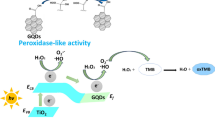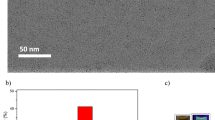Abstract
The authors describe the construction of a renewable electrochemical method for determination of honokiol in complex traditional Chinese herbs. A nanocomposite consisting of reduced graphene oxide and titanium dioxide was prepared and deposited on the surface of a glassy carbon electrode (GCE). This composite endows the GCE with self-cleaning capability via ultraviolet illumination. Under optimized conditions and at a typical working voltage of 0.54 V (vs. Ag/AgCl), the sensor has a linear response in the 0.025 to 10 μmol·L−1 honokinol concentration range, and the detection limit is 20 nmol·L−1 (at an S/N ratio of 3). The method was successfully applied to the determination of honokiol in cortex herbs and its galenicals.

Schematic of a photocatalytic self-cleaning electrochemical sensor based on reduced graphene oxide and titanium dioxide for honokiol detection. The method has successfully been applied to the determination of honokiol in Chinese herbs with satisfied results.





Similar content being viewed by others
References
Arora S, Bhardwaj A, Srivastava SK, Singh S, McClellan S, Wang B, Singh AP (2011) Honokiol arrests cell cycle, induces apoptosis, and potentiates the cytotoxic effect of gemcitabine in human pancreatic cancer cells. PLoS One 6:e21573
Zhang P, Liu X, Zhu Y, Chen S, Zhou D, Wang Y (2013) Honokiol inhibits the inflammatory reaction during cerebral ischemia reperfusion by suppressing NF-κB activation and cytokine production of glial cells. Neurosci Lett 534:123–127
Arora S, Singh S, Piazza GA, Contreras CM, Panyam J, Singh AP (2012) Honokiol: a novel natural agent for cancer prevention and therapy. Curr Mol Med 12:1244–1252
Zhao C, Liu ZQ (2011) Comparison of antioxidant abilities of magnolol and honokiol to scavenge radicals and to protect DNA. Biochimie 93:1755–1760
Wu X, Chen X, Hu Z (2003) High-performance liquid chromatographic method for simultaneous determination of honokiol and magnolol in rat plasma. Talanta 59:115–121
Yang J, Yu DS, Liu SP, Tian YF, Mo BB (2009) Simultaneous direct determination of magnolol and honokiol by second order derivative synchronous fluorimetry. Chin J Anal Chem 37:107–110
Chen CL, Chang PL, Lee SS, Peng FC, Kuo CH, Chang HT (2007) Analysis of magnolol and honokiol in biological fluids by capillary zone electrophoresis. J Chromatogr A 1142:240–244
Huang M, Wu Y, Hu W (2014) A facile synthesis of reduced graphene oxide-wrapped WO3 nanowire composite and its enhanced electrochemical catalysis properties. Ceram Int 40:7219–7225
Yang X, Gao M, Hu H, Zhang H (2011) Electrochemical detection of honokiol and magnolol in traditional Chinese medicines using acetylene black nanoparticle-modified electrode. Phytochem Anal 22:291–295
Zhang S, Chen X, Liu G, Hou X, Huang Y, Chen J, Zhan G, Li C (2015) A novel sensing platform based on ionic liquid integrated carboxylic-functionalized graphene oxide nanosheets for honokiol determination. Electrochim Acta 155:45–53
Ferreira M, Varela H, Torresi RM, Tremiliosi-Filho G (2006) Electrode passivation caused by polymerization of different phenolic compounds. Electrochim Acta 52:434–442
Centi G, Perathoner S (2010) Problems and perspectives in nanostructured carbon-based electrodes for clean and sustainable energy. Catal Today 150:151–162
Solla-Gullon J, Montiel V, Aldaz A, Clavilier J (2000) Electrochemical characterisation of platinum nanoparticles prepared by microemulsion: how to clean them without loss of crystalline surface structure. J Electroanal Chem 491:69–77
Schneider J, Matsuoka M, Takeuchi M, Zhang J, Horiuchi Y, Anpo M, Bahnemann DW (2014) Understanding TiO2 photocatalysis: mechanisms and materials. Chem Rev 114:9919–9986
Zhang X, Qin J, Xue Y, Yu P, Zhang B, Wang L, Liu R (2014) Effect of aspect ratio and surface defects on the photocatalytic activity of ZnO nanorods. Sci Report 4:4596
Suea-Ngam A, Rattanarat P, Chailapakul O, Srisa-Art M (2015) Electrochemical droplet-based microfluidics using chip-based carbon paste electrodes for high-throughput analysis in pharmaceutical applications. Anal Chim Acta 883:45–54
Svorc L, Sochr J, Svitkova J, Rievaj M, Bustin D (2013) Rapid and sensitive electrochemical determination of codeine in pharmaceutical formulations and human urine using a boron-doped diamond film electrode. Electrochim Acta 87:503–510
Kavitha T, Gopalan AI, Lee KP, Park SY (2012) Glucose sensing, photocatalytic and antibacterial properties of graphene–ZnO nanoparticle hybrids. Carbon 50:2994–3000
An X, Yu X, Jimmy CY, Zhang G (2013) CdS nanorods/reduced graphene oxide nanocomposites for photocatalysis and electrochemical sensing. J Mater Chem A 1:5158–5164
Zhang Y, Xiao S, Xie J, Yang Z, Pang P, Gao Y (2014) Simultaneous electrochemical determination of catechol and hydroquinone based on graphene–TiO2 nanocomposite modified glassy carbon electrode. Sensors Actuators B Chem 204:102–108
Yao W, Zhang B, Huang C, Ma C, Song X, Xu Q (2012) Synthesis and characterization of high efficiency and stable Ag3PO4/TiO2 visible light photocatalyst for the degradation of methylene blue and rhodamine B solutions. J Mater Chem 22:4050–4055
Asahi R, Morikawa T, Irie H, Ohwaki T (2014) Nitrogen-doped titanium dioxide as visible-light-sensitive photocatalyst: designs, developments, and prospects. Chem Rev 114:9824–9852
Guo J, Ouyang S, Li P, Zhang Y, Kako T, Ye J (2013) A new heterojunction Ag3PO4/Cr-SrTiO3 photocatalyst towards efficient elimination of gaseous organic pollutants under visible light irradiation. Appl Catal B Environ 134:286–292
Xiang Q, Yu J, Jaroniec M (2012) Synergetic effect of MoS2 and graphene as cocatalysts for enhanced photocatalytic H2 production activity of TiO2 nanoparticles. J Am Chem Soc 134:6575–6578
Zhang C, Xu JQ, Li Y, Huang L, Pang DW, Ning Y, Huang WH, Zhang Z, Zhang GJ (2016) Photocatalysis-induced renewable field-effect transistor for protein detection. Anal Chem 88:4048–4054
Xiang Q, Yu J, Jaroniec M (2012) Graphene-based semiconductor photocatalysts. Chem Soc Rev 41:782–796
Cai B, Wang S, Huang L, Ning Y, Zhang Z, Zhang GJ (2014) Ultrasensitive label-free detection of PNA–DNA hybridization by reduced graphene oxide field-effect transistor biosensor. ACS Nano 8:2632–2638
Yoo H, Kim Y, Lee J, Lee H, Yoon Y, Kim G, Lee H (2012) N-type reduced graphene oxide field-effect transistors (FETs) from photoactive metal oxides. Chem-Eur J 18:4923–4929
Sun D, Wang S (2015) Enhanced-oxidation and electrochemical determination of honokiol and magnolol using NMP-exfoliated graphene nanosheets. J Mol Liq 208:52–57
Akhavan O (2015) Bacteriorhodopsin as a superior substitute for hydrazine in chemical reduction of single-layer graphene oxide sheets. Carbon 81:158–166
Zhang Y, Zhang M, Zhu Y, Wei Q, Li X, Ou Y, Ao N, Zhang X (2015) A facile graphene Nanosheets-based electrochemical sensor for sensitive detection of Honokiol in traditional Chinese medicine. Electroanalysis 28:508–515
Zhao X, Xia X, Yu S, Wang C (2014) An electrochemical sensor for honokiol based on a glassy carbon electrode modified with MoS2/graphene nanohybrid film. Anal Methods 6:9375–9382
Zhang H, Chen S, Qin F, Huang X, Ren P, Gu X (2008) Simultaneous determination of 12 chemical constituents in the traditional Chinese medicinal prescription Xiao-Yao-san-Jia-Wei by HPLC coupled with photodiode array detection. J Pharmaceut Biomed 48:1462–1466
Zhang W, Li Y, Wu Q, Hu H (2012) Removal of endocrine-disrupting compounds, estrogenic activity, and Escherichia coliform from secondary effluents in a TiO2-coated photocatalytic reactor. Environ Eng Sci 29:195–201
Mor GK, Carvalho MA, Varghese OK, Pishko MV, Grimes CA (2004) A room-temperature TiO2-nanotube hydrogen sensor able to self-clean photoactively from environmental contamination. J Mater Res 19:628–634
Acknowledgments
This work was supported by the National Natural Science Foundation of China (Nos. 21475034 and 21675041) and the National Science and Technology Major Project for “Major New Drugs Innovation and Development” (no. 2014ZX09304307001-021).
Author information
Authors and Affiliations
Corresponding authors
Ethics declarations
The author(s) declare that they have no competing interests.
Electronic supplementary material
ESM 1
(DOC 1470 kb)
Rights and permissions
About this article
Cite this article
Lei, Y., Yang, F., Li, YT. et al. Photocatalytic self-cleaning electrochemical sensor for honokiol based on a glassy carbon electrode modified with reduced graphene oxide and titanium dioxide. Microchim Acta 184, 2299–2305 (2017). https://doi.org/10.1007/s00604-017-2239-7
Received:
Accepted:
Published:
Issue Date:
DOI: https://doi.org/10.1007/s00604-017-2239-7




